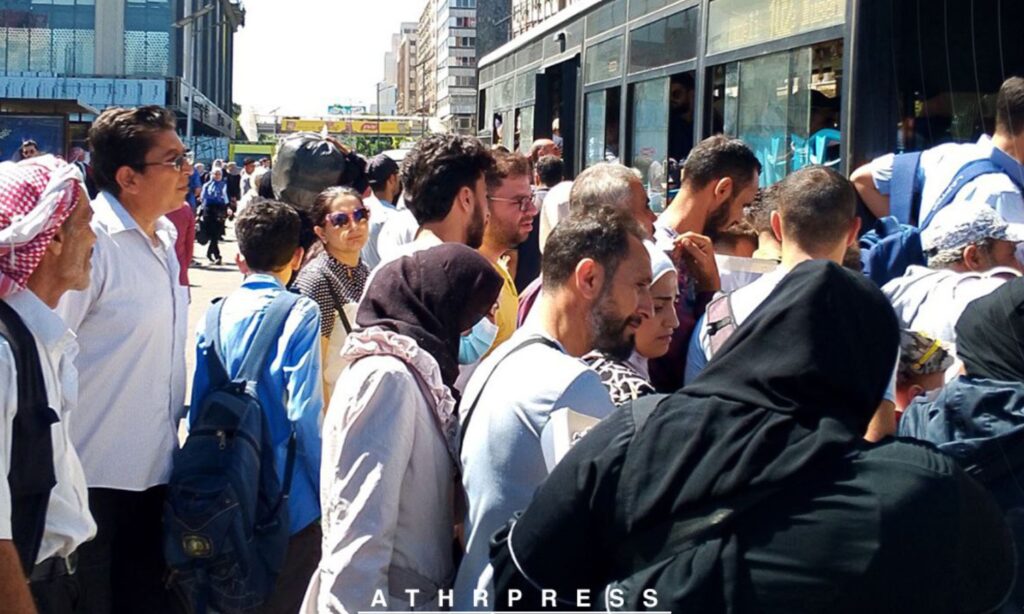The fuel crisis in areas under Syrian regime control has been ongoing for nearly a month, with no governmental solutions to mitigate it, especially with the drop in temperatures and increased demand for fuel.
Since the beginning of last September, regime-controlled areas have been suffering from a fuel shortage, which continues to this day, affecting many services such as transportation, and increasing food prices.
Fuel prices in the black market continue to rise due to scarcity. The price of a liter of diesel has reached approximately 28,000 Syrian pounds, while the price of gasoline is about 25,000 pounds, a situation attributed by local media to the Israeli escalation in Lebanon.
Local news site “Athr Press” quoted the head of the Consumer Protection Association in Damascus, Abdul Aziz Moqalli, as saying that fuel smuggling operations from Lebanon to Syria are still ongoing, with expectations that they may decrease soon.
The regime’s government distributes fuel rations to residents in its controlled areas in a regulated manner, which forces them to resort to the black market to cover their needs, where prices vary according to demand and the availability of subsidized materials. Prices double during recurring fuel crises and decline when materials are available systematically.
Exacerbating transportation crisis
The lack of fuel is the main crisis, opening the door to accompanying crises such as halting production in some factories and professions that heavily depend on fuel, reducing electricity supply, and causing a transportation crisis. Transport drivers cannot work without receiving their fuel rations.
The fuel shortage in the regime-controlled government has caused a transportation crisis in many major cities such as Damascus, Aleppo, and Homs, causing congestion at parking lots and depriving some citizens from traveling between provinces.
Due to the lack of subsidized fuel obtained through the smart card, many bus companies have stopped operating in Homs province due to the severe shortage of diesel needed to run buses.
Bashar Abdullah, a member of the executive office for the transportation sector in Homs province, stated in an interview with local TV “Al-Khabar” that the office has taken some measures to alleviate the emergency transportation crisis and some of the congestion on certain lines between Homs and other provinces.
Abdullah attributed the worsening crisis to the increased number of arrivals from Syria and Lebanon due to the Israeli escalation on Lebanon, as well as errors in the electronic tracking (GPS) mechanism.
In connection to the worsening transportation crisis in Aleppo province, Mohammad Fayadh, a member of the executive office of the province, said in a press statement that the Mahrukat company has been ordered to supply minibusses operating on city lines with 50% of their allocations regardless of the electronic card, and to supply buses operating between provinces with 85% of their allocations as well.
Most consumer goods are affected by the increased fuel prices, amid low purchasing power and deteriorating economic conditions, causing many families to rely on remittances from Syrians living abroad to meet their minimum living requirements.
No solutions, Regime raises prices
In the past period, the Syrian regime government did not clearly state any solutions on the horizon for the fuel crisis, rather linking the solution to the quantity of supplies.
On the contrary, the regime increased the prices of fuel distributed either subsidized or unsubsidized through the smart card twice last September.
Typically, the regime government resorts to raising fuel prices, citing “ensuring its availability and increased import costs.”
Since the adoption of a periodic bulletin (issued every 15 days) for fuel prices in areas controlled by the Syrian regime at the end of last year, based on cost prices, there have been significant changes in material prices, with most bulletins showing price increases.
Despite the Ministry of Petroleum’s statement of starting the distribution of heating diesel as of October 1st, focusing on giving priority to cold areas, distribution is usually delayed each year, with citizens possibly not receiving their allocations until months into the winter season.
No expected relief
Syria ranks second among countries to which Iran exports oil, receiving tens of thousands of barrels daily, according to the UANI site, specialized in tracking Iranian oil tankers around the world.
Doctor of financial and banking sciences, Firas Shaabo, told Enab Baladi that the Israeli escalation on Lebanon and the ensuing displacement of numbers exceeding hundreds of thousands of Lebanese and Syrians to regime areas will intensify the fuel crisis due to increased demand and the regime’s inability to increase supply.
Fuel sources on which the regime relied from Hezbollah and Iran may face attacks from Israel, exacerbating the crisis. Consequently, the dire economic situation for residents in regime-controlled areas will continue.
The researcher believes that the regime may exploit this displacement and its inability in many sectors, mainly fuel, to appeal to international organizations for resources, which could save it from bigger crises. Moreover, exploiting other issues such as remittances could fill its treasury with significant foreign currency amounts.
On September 30, the United Nations High Commissioner for Refugees (UNHCR) reported that the number of people crossing from Lebanon to Syria due to the Israeli escalation reached about 100,000 Lebanese and Syrians. The updated estimates indicate that approximately 60% of those who crossed the border to Syria were Syrians, while Lebanese made up about 40%.

